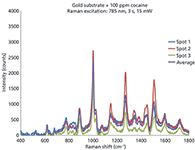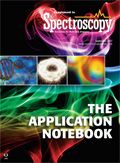SERS Methods Detect Trace Levels of Cocaine, Heroin, Methamphetamine, and THC
Application Notebook
Surface enhanced Raman spectroscopy (SERS) is an extension of Raman spectroscopy in which gold or silver nanoparticles amplify the Raman signals. The technique works via an electromagnetic effect where molecules come into proximity with gold or silver particles. When incident laser light strikes the nanoparticulate surface, localized surface plasmons can be excited, greatly enhancing Raman signals. The enhancement can be significant, making SERS well-suited to trace level detection of illicit drugs such as cocaine, heroin, methamphetamine, and tetrahydrocannabinol (THC).
To test how well Ocean Optics SERS substrates can detect trace drugs, measurements were performed using gold and silver nanoparticles with an Ocean Optics modular Raman setup. As we discovered, detection of several illicit drugs using gold nanoparticles is a rapid, reliable technique that requires only a few milliwatts of laser power.
Sample Preparation
Heroin hydrochloride, cocaine hydrochloride, Δ9-tetrahydro-cannabinol, and (±)-methamphetamine were prepared in 100 ppm solutions in methanol.
For the Ocean Optics SERS substrates, which comprise analyte-sensitive nanoparticle chemistries applied to a treated glass surface, we used 15 µL of 100 ppm solutions for the gold and silver nanoparticle substrates. We tested at 100 ppm to determine feasibility, although results suggest lower concentrations are possible.

Experimental Setup
For measurements with the gold and silver SERS substrates, we used a modular Raman system comprising the QE Pro high-sensitivity spectrometer, a 785 nm laser for Raman excitation, and sampling optics. The 785 nm excitation produces excellent Raman spectra for most chemicals, with limited interference from fluorescence. These systems also offer very good spectral resolution, making them a preferred wavelength choice for Raman spectroscopy of chemicals and organic materials. Three measurements for each sample were taken from multiple spots on the same substrate, which then were averaged.

Results
As demonstrated in the spectra, SERS methods utilizing Ocean Optics substrates can detect ppm levels of illicit drugs, which Raman techniques alone would not be able to accomplish.
Also, the gold nanoparticles appear to work best for detecting these drugs. Certain peaks have higher Raman cross-sections, and each peak is enhanced by the gold nanoparticles differently depending on how the molecule is oriented with respect to the gold surface.

Ocean Optics
8060 Bryan Dairy Rd., Largo, FL 33777
tel. (727) 733-2447
Website: www.oceanoptics.com
